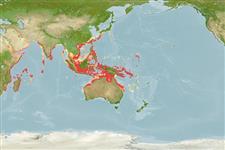Common names from other countries
Environment: milieu / climate zone / depth range / distribution range
Ekologi
marina bottenlevande; djupintervall 5 - 70 m (Ref. 12260). Tropical; 26°C - 29°C (Ref. 4959); 32°N - 27°S, 34°E - 169°E
Indo-West Pacific: East Africa to northern Australia and New Caledonia.
Size / Vikt / Age
Maturity: Lm ? range ? - ? cm
Max length : 25.0 cm TL hane/ej könsbestämd; (Ref. 48635); common length : 10.0 cm TL hane/ej könsbestämd; (Ref. 30573)
Taggstrålar i ryggfenan (totalt) : 8; Mjukstrålar i ryggfenan (totalt) : 16; Taggstrålar i analfenan: 3; Mjukstrålar i analfenan: 14.
Found in coastal inshore waters over mud or sand bottoms, rarely near reefs (Ref 90102). Stays near the substrate and feeds on small shrimps, other crustaceans, and polychaetes (Ref. 5213). A flighty species during the day (Ref. 48635).
Life cycle and mating behavior
Maturities | Reproduktion | Spawnings | Egg(s) | Fecundities | Larver
James, P.S.B.R., 1984. Leiognathidae. In W. Fischer and G. Bianchi (eds.) FAO species identification sheets for fishery purposes. Western Indian Ocean (Fishing Area 51). Vol. 2. FAO, Rome. pag. var. (Ref. 3424)
IUCN Red List Status (Ref. 130435)
CITES (Ref. 128078)
Not Evaluated
Threat to humans
Harmless
Human uses
Fiskeri: kommersiell
Verktyg
Special reports
Download XML
Internet-källor
Estimates based on models
Preferred temperature (Ref.
115969): 24.7 - 29, mean 28 (based on 1144 cells).
Phylogenetic diversity index (Ref.
82804): PD
50 = 0.5010 [Uniqueness, from 0.5 = low to 2.0 = high].
Bayesian length-weight: a=0.01288 (0.00802 - 0.02069), b=3.12 (2.99 - 3.25), in cm Total Length, based on LWR estimates for this species & (Sub)family-body (Ref.
93245).
Trofisk nivå (Ref.
69278): 3.1 ±0.2 se; based on diet studies.
Resiliens (Ref.
120179): Hög, lägsta populationsfördubblingstid mindre än 15 månader (K=0.93-1.80).
Fishing Vulnerability (Ref.
59153): Low vulnerability (13 of 100).
